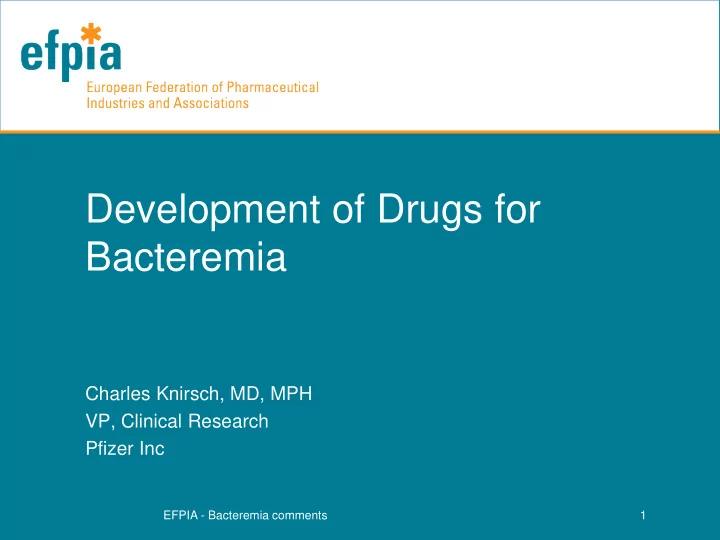

Development of Drugs for Bacteremia Charles Knirsch, MD, MPH VP, Clinical Research Pfizer Inc EFPIA - Bacteremia comments 1
Bacteremia Guidance Issues • EMA guidance suggests that bacteremia is not a primary diagnosis but represents ‘isolation from the blood of an organism....contributing to signs and symptoms of infection in a patient” – EFPIA agrees with this concept of associated bacteremia • Focus for today: S. aureus bacteremia (SAB) is a unique and very important medical entity – Heterogeneity of infection makes study design challenging – Evidence base weak for clinical guidance • Consider translating SAB features to bacteremia from MDR Gram-negative organisms EFPIA - Bacteremia comments 2
The Problem with S. aureus Bacteremia • “The best way to manage SAB will remain unknown until the key clinical questions have been addressed by large, rigorous RCTs” • UK Infection Study Group, Thwaites et al Lancet 2011 • Regulatory pathway to encourage SAB trials? • SAB can help inform considerations for other multi- drug resistant organisms EFPIA - Bacteremia comments 3
Key Themes for this review • S. aureus bacteremia is a cluster of diverse syndromes – Mortality is actually highest when there is no obvious site • Events defining outcomes are diverse – There is no obvious single best measure – Without a composite endpoint, clinical trials don’t seem feasible EFPIA - Bacteremia comments 4
SAB : Wide Spectrum without Predominant Clinical Phenotype • Uncomplicated bacteremia (no spread) • Complicated bacteremia (persistence or spread) • Bacteremia associated with removable focus • Uncomplicated right-sided endocarditis in IV drug users with normal valves and no 2 ndry sites • Complicated right-sided endocarditis (all others) • Left-sided endocarditis • Bacteremia without identified source common and associated with high mortality EFPIA - Bacteremia comments 5
High Mortality in SAB: particularly in patients w/o a site identified • 549 UK patients – MSSA and MRSA • Removable: IV catheter: 21% (113/549) • Removable, other source: 20% (110/549) • Site not established 19% (101/549) • Not removable : 40% (213/549) – Soft tissue comprised 34% – Endocarditis 5% • 24% mortality: 32% within 3 days; 40%: 4-14 days • Highest mortality in “not established” group (45%) – SAB Prospective Study Thwaites. PLoS ONE: Dec 2010 EFPIA - Bacteremia comments 6
The Evidence Base: Daptomycin all comers trial * • ~2.5 yrs to enroll comparative trial vs. standards of care (vancomycin, oxacillin etc) – Spectrum of bacteremia including catheter-related BSI – 30 daptomycin pts with right-sided endocarditis • 246 pts randomized- 158 completed • 44.2% daptomycin success vs. 41.7 comparator – Difference = 2.4% ; 95% CI: -10.2 to 15.1% • Bacteremia subsets numerically similar outcomes between daptomycin and comparator – Similar results in RIE to SOC • Indication granted for RIE and skin source subsets but not general bacteremia *EMEA EPAR Scientific Discussion EFPIA - Bacteremia comments 7
All-Comers SAB Trial: ways to optimise precision and analysis • Adjust predictive baseline • Composite Primary Endpoint pre-specified variables – Time to clearance of bacteremia – Length of bacteremia – Overall Investigator assessment of Clinical response – Endocarditis location (R, L) (normalization of signs and – Removable focus symptoms of infection at EOT – Time in Hospital prior to and proof of cure) bacteremia – Time to clearance of select – Age SIRS measures (BP, – Time of prior antibiotics tachycardia) EFPIA - Bacteremia comments 8
Advantages and Disadvantages of Composite Endpoints • Statistical efficiency and • Difficulty in assigning weights to reduced sample size components requirements. ─ Improvement can be – Increased events rates driven by less important component(s) of the • Avoiding adjustments for composite endpoint multiple comparisons • Avoiding arbitrary choice of a single outcome when many • Effects observed on individual may be of equal importance. components may not move in the same direction. • Allows the measurement of “overall” benefit of the treatment • Need to adjust for multiplicity to • Useful when a single primary draw conclusions about the endpoint is hard to choose individual components EFPIA - Bacteremia comments 9
Relationship of Bacteremia and Traditional Indications cSSTI Complicated IABD CRI Meningitis Bacteremia UTI Osteomyelitis CAP Endocarditis Knirsch: FDA Anti-infective Advisory Committee Meeting. October 14, 2004: 10
MDR gram negative product studied across traditional indications; Ways to optimise precision and analysis • Adjust predictive baseline • Composite Primary Endpoint pre-specified variables – Time to clearance of bacteremia – Source of bacteremia – Overall Investigator assessment of Clinical response – Removable focus (normalization of signs and – Time in Hospital prior to symptoms of infection at EOT bacteremia and proof of cure) – Age – Time to clearance of select – Time of prior antibiotics SIRS measures (BP, tachycardia) EFPIA - Bacteremia comments 11
Bacteremia labeling – important information for a treating physician • S. aureus bacteremia could be studied as a single entity as part of a spectrum of disease – Model-based statistics to adjust for baseline factors and length of therapy and pre-specify composite primary endpoint – Include S. aureus catheter-related bacteremia • MDR Pathogens: accumulate sufficient clinical data to support an indication for bacteremia • Two options: – With robust non-clinical data and PD data in several tissue sites, multiple organisms in bacteremia should be possible – Additionally, single pathogen from numerous different sites could be aggregated for bacteremia labeling considerations EFPIA - Bacteremia comments 12
Summary • S. aureus bacteremia is – Medically relevant information for prescribers – Amenable to a special pathway studying full spectrum of entity as a secondary indication including Catheter BSIs – Appropriate as a place to use statistical techniques to enhance efficiency of study • “Associated bacteremia” labeling medically relevant for MDR Gram-negative bacteremia – Organism-specific bacteremia labeling from across indications from a Tier C program – Multiple MDR organisms from a single indication when strong in vitro microbiology, PK/PD, and animal data from a Tier B program EFPIA - Bacteremia comments 13
Recommend
More recommend